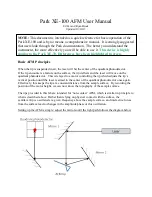
3 Product and Functional Description | 3.3 Optional Components and Accessories
ZEISS
3.3.1.3 BSD Detector
Purpose
The BSD detector is a pneumatically retractable backscattered electron detector. It is used for high
efficiency material characterization even at low-kV applications. It has four separate diode quad-
rants S1 to S4 and an additional shadow segment S5 for strong topography contrast.
detector with four diode quadrants and a fifth shadow segment
NOTICE
Risk of property damage: Motorized specimen stage
Risk of damaging the detector when operating the motorized specimen stage.
4
Retract the detector head completely after you have finished the work with the detector.
Info
Risk of malfunction: The diode segments are sensitive to the light that is used for illumination
in TV mode (infrared and white).
When you use a diode detector, always make sure that the TV illumination is switched off. If
the CCD Mode is set to Auto Detect, then the TV illumination is automatically switched off
when a diode detector is used.
The BSD detector has applications mainly in materials analysis and in the life sciences.
Material analysis:
§
Metallurgical sections
§
Geological sections
§
Complex materials
§
Printed circuit boards
§
Semiconductors
§
Bond pads
Life sciences:
§
Mineral deposits in plant structures
§
Bone structures
The BSD detector is available either with one video output channel (BSD1) or with four video out-
put channels (BSD4). With BSD4 you can collect four channels in parallel, which can be displayed
in Quad mode. Each channel can have an arbitrary combination of segments. This way, you can
collect compositional images, topographical images, and custom combinations all at once.
46
Instruction Manual ZEISS Crossbeam 550L, Crossbeam 550 | en-US | Rev. 3 | 349500-8122-000
Содержание Crossbeam 550
Страница 135: ......
















































